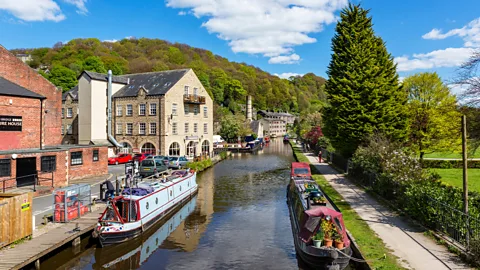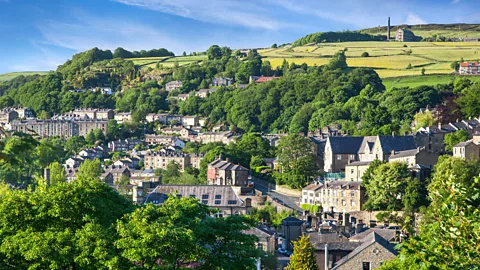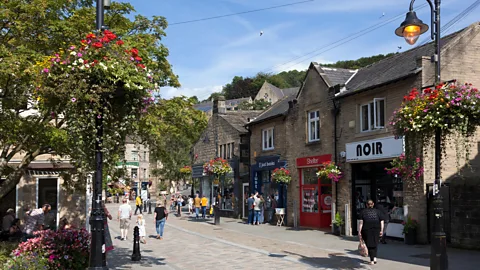Hebden Bridge: The surprising 'lesbian capital of the UK'
 Alamy
AlamyHome to just 4,500 people and set in a scenic, rural valley, this quaint market town has blossomed into a bastion of tolerance.
"None of the bars here are gay bars," said Liz Paton. "But at the same time, they all are."
Paton is the charismatic owner of Drink, an independent taproom in the Yorkshire market town of Hebden Bridge, where my boyfriend and I were visiting for a long weekend.
Nestled between Manchester and Leeds in the scenic Upper Calder Valley, for years this rural town – which calls itself a "bohemian paradise", thanks to its many eco-friendly shops, artisan markets, galleries and indie bookstores – had been on my wish list. And so on my recent birthday, we finally booked a trip to stroll its cobbled streets, explore its rivers and canals, climb the surrounding wooded hillsides and – of course – gaze down from its eponymous 16th-Century packhorse bridge.
Though only boasting a population of roughly 4,500 people, this small, peaceful community has long been known as "the lesbian capital of the UK" – 8.95% identified as LGBTQ+ in the last Census. I was curious to trace the queer history of "Trouser Town" (a nickname referencing Hebden Bridge's manufacturing heritage). But as I soon discovered, its evolution from a rural mill town to a tolerant bastion was a bit blurry.
 Alamy
AlamyBack in the 1970s, artists and activists were drawn here by cheap housing after the cotton mills shut down. "One historical and cultural factor [that helped establish a burgeoning lesbian community] may have been the separatist wing of 1960s and 1970s feminism," said Dr Andrew Moor, who teaches film studies at Manchester Metropolitan University. "There was an element which allied itself with alternative hippy culture's experiments in alternative living, communes and a resistance to full-throttle capitalism. Hebden was the right size and in the right place."
Former resident Bev Manders moved here in the 1980s. "Certainly up to 1986, lesbians weren't particularly visible as far as I can ascertain," she said. But so steady was the growth of the community that, in neighbouring Todmorden, a monthly Women's Disco was launched. "The first took place on New Year's Eve 1986 at Cornholme Church Hall," said Manders. "With a fair amount of women there, it's my belief that this is the point we became more visible, and it also gave others the impetus to be visible – and some to come out."
The disco was held in various venues before relocating to Todmorden Cricket Club, where it still takes place on the second Saturday of the month. "Within a short time, word got out and there'd be women coming from Bradford, Leeds, Burnley and even Cumbria, Blackpool and Nottingham."
From 1986 to the early 1990s, Manders recalls that "an influx of lesbians" descended on the small town. "A number moved to the valley as they knew someone who lived there or had previously visited. Others had heard through the grapevine about this 'new' place with lesbians. In addition to the disco, there were writers' groups, book clubs, a choir and walking groups. Some were exclusively lesbian, some women-only."
By the late 1990s a monthly pamphlet, Lesbian Zone, was available to buy via subscription or at specific bars – and by 2004 Hebden had the highest number of lesbians per capita in the UK.
 Stephen Emms
Stephen EmmsBar owner Paton was born and raised in Calderdale but drawn to Hebden from a young age. "I was aware of the 'lesbian hippy' moniker," she said. "It was about seeking refuge amongst more open-minded people: artists and new-wave travellers made for happy bedfellows during the 1970s and '80s."
Tim Whitehead, now artistic director of Happy Valley Pride, which welcomes thousands of people from across the country every July, is another Hebden Bridge resident who grew up nearby but was drawn to its countercultural side. "I used to come here in the 1980s with my family. Whereas other Yorkshire towns were like [the pensioner-centred 1970s BBC sitcom] Last Of The Summer Wine, you'd come into Hebden and it would be people in caftans wandering around. But there was always a mix: hippies, artists and the lesbian community, as well as traditional Yorkshire town people."
Lou Millichamp arrived in Hebden in 1994 knowing no one and started running the subterranean Nelson's Wine Bar in 1997: originally set up by two gay men, it was one of Hebden's first safe spaces that welcomed both lesbians and queer men. "In the '90s when I worked there," said Manders, "Friday nights would be heaving with lesbians and gay men from the valley and nearby areas."
Today, Millichamp still runs Nelson's in "a partnership" with two other women. It's now a candle-lit vegan bar and restaurant serving innovative small plates like king oyster "scallops" with coconut pea puree and crispy kale; and a tomato, pistachio and saffron tart. As we ate, we watched lively groups of mostly LGBTQ+ folk clinking wine glasses all around us.
 Alamy
AlamyDespite such tolerance, it was, sadly, still homophobia that proved the catalyst for Happy Valley Pride (the area's nickname – and the inspiration for the hit BBC show – is due to long-associated issues with drugs). In 2015 a piece of homophobic graffiti appeared in Hebden on "a big piece of tarpaulin", said Whitehead. "So a group of locals, led by Darren Spruce, took it down and invited members of the community to turn into an enormous artwork as a way of reclaiming it."
A year later, in 2016, Spruce contacted Whitehead to programme acts for a week-long festival with a main event on the Saturday, and Happy Valley Pride took root. Now attracting more than 6,000 attendees each year, the grassroots event nonetheless pulls in performers from legendary London club Duckie. "There are free events, workshops, talks and dancing," said Paton. "Very few things are ticketed, and it's a glorious cross section that shows how very mundane being gay is. We're not trying to overtake anything: we just want people to stop equating our sexualities with sexual deviance."
Part of Happy Valley Pride's focus is on its two neighbours, Todmorden and Mytholmroyd, both of which make scenic canalside strolls (in opposite directions) from Hebden.
Todmorden has a gritter, more industrial feel than its rival, and "the gay community tends to be on the younger side", said Paton. Here, we enjoyed pints at independent bar-venue Nan Moor's, popular with both local and offcumden (a Yorkshire word meaning "not-from-round-here") LGBTQ+ visitors.
"We noticed a lack of programming of women, non-binary and LGBTQ+ folks in the area," said Lauren de Sá Naylor, who opened Nan Moor's in 2020 with her business partner Alice Jackson. "So, we put them to the front, along with 'experimental' performances. And these genres include more queers and women. We hold a monthly 'open-decks' just for aspiring female, non-binary and LGBTQ+ DJs, and fringe events alongside Happy Valley Pride."
Back in Hebden, the usually quiet town was rammed with tourists during a bank holiday weekend. According to Millichamp, these days Hebden is "a destination with big groups of day trippers at weekends" and she notes that "some locals [are being] pushed out and outpriced". Covid proved a turning point. "We had a big influx of people, both gay and straight, coming from the cities, wanting to change lifestyles and buying smaller mortgage-free properties, along with the rise of Airbnbs. The markets have changed from selling functional everyday wares to tourist trinkets, with more food stalls to serve the increasing flow of tourists."
Despite the thrum of visitors, a heady air of tolerance still pervades, and I soon understood what Paton meant when she said that everywhere and nowhere in Hebden was a gay bar.
After leaving Drink, we wandered to the taproom Vocation; queer-friendly pub The Albert, with its Progress Pride flags flying high outside; and – a must – the historic socialist music venue Trades Club. Literary-minded visitors will also thrill at iconic poet Sylvia Plath's grave, a steep climb uphill in Heptonstall, and Shibden Hall, the home of 19th-Century diarist Anne Lister, the so-called "first modern lesbian", half an hour's drive away.
"I feel the desire in Hebden has been simply to exist in a wider community without having to justify your relationship," said Paton. "There have been occasions when LGBTQ+ tourists have come looking for some mythical place where everything is set up for gays and everyone is gay. It is, in fact, a community that doesn't give enough of a damn about people's sexuality to make it a problem."
--
If you liked this story, sign up for The Essential List newsletter – a handpicked selection of features, videos and can't-miss news delivered to your inbox every Friday.
